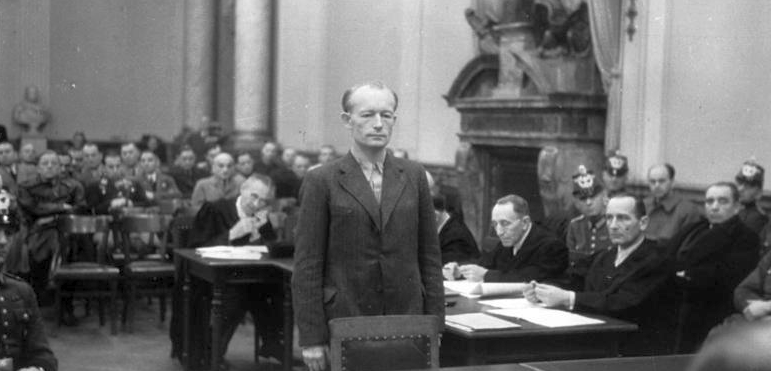It was a show trial. Except it wasn’t in Moscow. It was in Brooklyn.
The guilt of the defendant was never in question. It was an honest-to-God American show trial. It was a display of an “enemy of the people” at the moment he is smitten by the righteous might of American justice.
It was the titans of American jurisprudence versus a short pudgy peasant from the highlands. Sure, he had a shrewd mind, and an ability to make friends in high places. But it wasn’t enough.
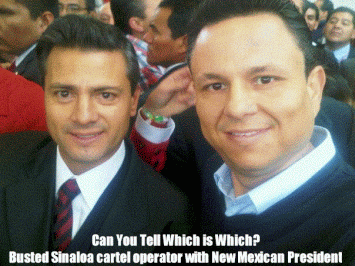 There were no photos presented as evidence of Mexican Presidents shaking hands with expensively-groomed cartel lieutenants in casual attire.
There were no photos presented as evidence of Mexican Presidents shaking hands with expensively-groomed cartel lieutenants in casual attire.
El Chapo Guzman’s decades-long pass to roam the world has been cancelled. Shorty’s vacations, in everywhere from Monaco to Macau, are a thing of the past.
His personal gulag will resemble the inside of a SuperMax in a harsh climate where a cold wind blows.
“The regime lacks, you know, credibility“
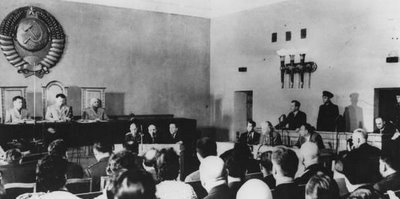 Except… as show trials go, it wasn’t successful. The “mighty justice” being meted out didn’t look good when it was held up to the light.
Except… as show trials go, it wasn’t successful. The “mighty justice” being meted out didn’t look good when it was held up to the light.
It did nothing to allay suspicions that have grown over decades that those in power share complicity with the man being judged.
It was noticed that prosecutors didn’t bother even trying to explain how Guzman— and the rotating list of Pablo Escobar-ish characters before him— could operate in the face of a government that can read the make of your golf ball from outer space while keeping time with the music you use when you put people on hold on your satellite phone.
Like a rebel general brought back to Rome in chains, the Sinaloa Cartel honcho was paraded before the cameras. In the process he went from a man who desperately needed a shower and a shave to an almost sympathetic character.
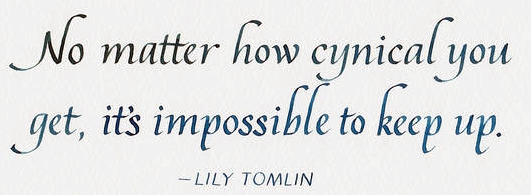
He became the latest sacrificial lamb to America’s “War on Drugs,”whose annual cost of $40 billion would fund a 30-foot high wall around America with money left over for regular towers and turrets around its entire circumference.
The most true thing that can be said about the trial of El Chapo Guzman is the memorable quote from comedian Lily Tomlin: “No matter how cynical you get, it’s impossible to keep up.”
Tuna boats, drunken Mexicans, climate change
The best news coverage of the trial was in the New York Times, which professed itself excited by the tabloid revelations.
“What do tuna boats, paramilitaries, drunk Mexicans, climate change, an ostrich farm and a prison escape party have in common? El Chapo’s fascinating can’t-make-this-stuff-up-if-you-tried trial.”
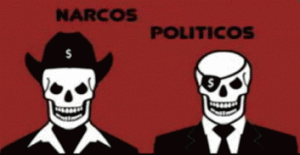 But there is something else that renders their reporting ironic and postmodern, because the unspoken truth is that one of the paper’s major investors, Mexican oligarch Carlos Slim, who saved the paper from bankruptcy a decade ago, is also odds-on favorite in speculation about the identity of the ‘Padrino’ behind Mexico’s biggest industry, which is, of course, drug trafficking.
But there is something else that renders their reporting ironic and postmodern, because the unspoken truth is that one of the paper’s major investors, Mexican oligarch Carlos Slim, who saved the paper from bankruptcy a decade ago, is also odds-on favorite in speculation about the identity of the ‘Padrino’ behind Mexico’s biggest industry, which is, of course, drug trafficking.
While Mr. Slim was showing his touching commitment to a free press with the Sulzberger family in New York during the global financial crisis in 2008, the head of the United Nations’ watchdog Office on Drugs and Crime, UNODC, Antonio Maria Costa, had been impolitic enough to blurt out a truth far more inconvenient than rising sea levels.
Worse, for him, Reuters reported it.
“Money made in the illicit drug trade is being used to keep banks afloat in the global financial crisis,” Maria Costa told Reuters.
“In the midst of the current world financial crisis, drug money is, in many instances, currently the only liquid investment capital,” Costa said. “With little unemployment, the drug trade at this time could be the world’s only growth industry.”
Most people, perhaps naively, think of drug money as bad. Carlos Slim’s investment in the N.Y. Times illustrates the fact that not everyone agrees.
A little bit of backstory
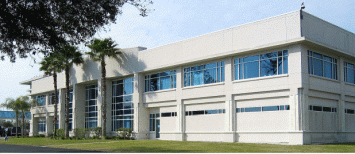 In 1990, Mexico’s only mobile phone provider Telefonos de Mexico (Telmex) was bought by a group of investors led by Carlos Slim, Mexico’s richest man, who later bought a stake in the New York Times. In 2003 Verint, then called Comverse, was chosen by Telmex, as stated in their press release, to “Implement a Widespread Expansion of Voicemail Services.”
In 1990, Mexico’s only mobile phone provider Telefonos de Mexico (Telmex) was bought by a group of investors led by Carlos Slim, Mexico’s richest man, who later bought a stake in the New York Times. In 2003 Verint, then called Comverse, was chosen by Telmex, as stated in their press release, to “Implement a Widespread Expansion of Voicemail Services.”
“In 2006 the Bush Administration entered into a quiet agreement with the Mexican Government to fund and build an enormous $3 million telephone and Internet eavesdropping vendor that would reach into every town and village in the country,” reported James Bamford.
In fact, the 2003 press release from Carlos Slim’s Telmex suggests the program in Mexico probably began three years earlier.
“The purpose is to create swift investigative measures against organized crime,” said Mexican president Felipe Calderon at the time the deal was announced.
Reported Sam Enriquez in the Los Angeles Times:
“Although the proposal stems from the president’s noble intention of efficiently fighting organized crime, the remedy seems worse than the problem. The system the Bush Administration chose for Mexico is similar to the warrant-less eavesdropping operation in the U.S., and used the same vendor, the Israeli company Verint, founded by veterans of that country’s NSA, the hyper-secret Unit 9200.”
“Paid for by the U.S. State Department, it was installed by a politically well-connected firm based in Melville, N.Y., that specializes in electronic surveillance.”
The never-ending scandal
 And one more thing, reported exclusively here , in more than one hundred stories, for more than a decade:
And one more thing, reported exclusively here , in more than one hundred stories, for more than a decade:
Carlos Slim’s partner Verint owned the corporate headquarters (pictures above )where SkyWay Aircraft made its home in St. Petersburg Florida while the company’s two DC-9’s ran drug flights, one of which was busted carrying a record (in Mexico!) 5.5 tons of cocaine.
Probably just a coincidence.
If you think otherwise, you may be interested in The Cocaine One archives, which contain more than 100 colorful stories of the drug trade as if it belonged in the real world, instead of in the realm of taboo. DC-9 with 5.5 tons of cocaine has links to the CIA might be a good place to start. Or San Diego Defense Contractor’s mysterious links to 5.5 ton cocaine bust.
Or you can read about the connections of Trump campaign officials to the company. It’s a good way to get started learning about RussiaGate, which is all anyone will be hearing about for the next two years.
But hey, you can really jump in almost anywhere.
Because it’s a never-ending scandal.
The New York Times, drug money, and Carlos Slim
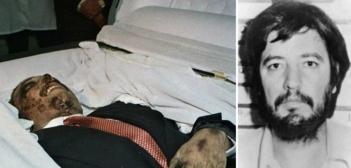 When Amado Carrillo Fuentes, known in Mexico as “Lord of the Skies” for his vast armada of planes, died in 1997 while undergoing plastic surgery, according to the AP he was worth $25 billion.
When Amado Carrillo Fuentes, known in Mexico as “Lord of the Skies” for his vast armada of planes, died in 1997 while undergoing plastic surgery, according to the AP he was worth $25 billion.
That meant Drug Lord Amado Fuentes managed to salt away $10 billion a decade, in a business where counting your money is often a much bigger problem than making it.
Turn now to Mexico’s richest oligarch Carlos Slim, whose links to the drug trade have been rumored for years.
After working hard for more than 40 years, Carlos Slim was worth a hefty sum. According to numerous published reports, he was worth $6 billion in the year 2000. In 1992 Fortune magazine pegged his net worth was 2.8 billion.
Seven years later Mexico City newspaper La Jornada on May 7, 1999 fixed Slim’s fortune at “something like $6 billion.” At the same time Latin Trade magazine pegged his net worth at $7.2 billion.
Yet in 2009, when Slim made his big investment in the New York Times, according to news reports he was worth between $57 billion and $60 billion dollars.
Has anyone in history ever made $50 billion in just ten years? Not by doing anything legal.
Mexico’s richest man is dirty. So is every Mexican President’s for the past 50 years, as well as a huge chunk of the nation’s elite. That’s nothing new.
But what is new is an increasingly widespread desire to see some of America’s Drug Lords doing the perp walk.
When that day comes, we will all– Mexicans and Americans alike–be much better off.

